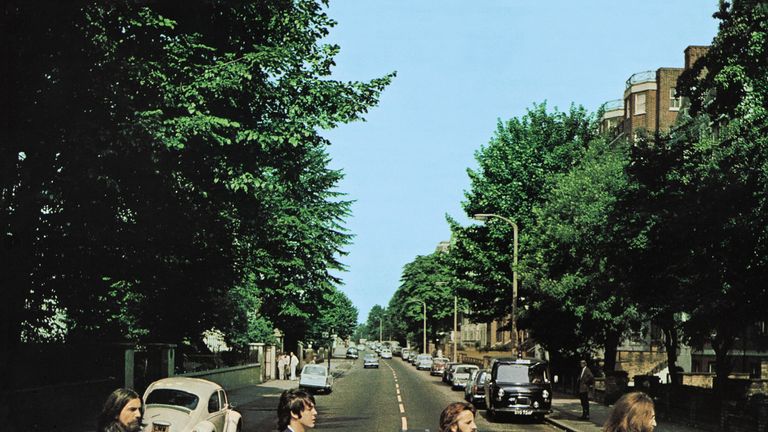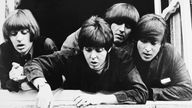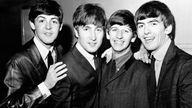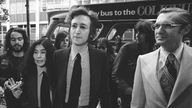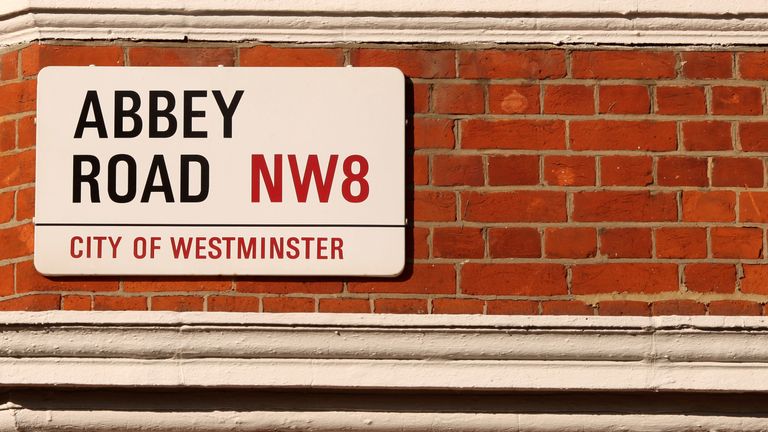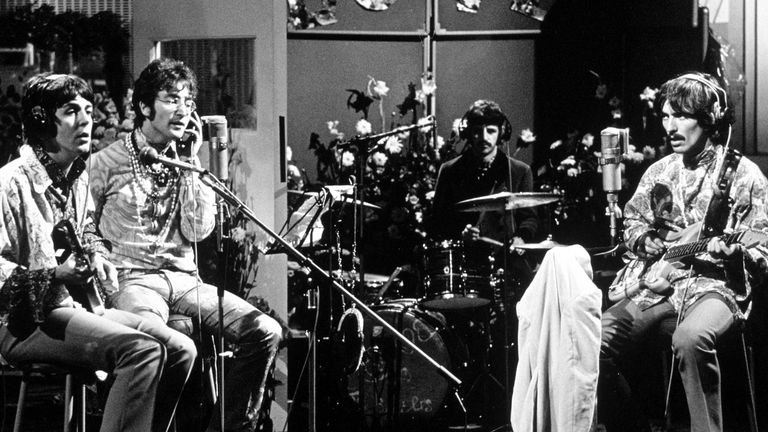Abbey Road: The story behind the famous cover
On the 50th anniversary of the iconic Abbey Road cover photograph being taken, Sky News takes a look at how it came about.
Thursday 8 August 2019 15:11, UK
On 8 August 1969, a photograph was taken that would turn an ordinary zebra crossing into one of the most recognisable street locations in the world.
Fifty years on, Abbey Road in London's St John's Wood remains a must-visit for any true Beatles fans, the place to go to recreate the famous strides of the Fab Four in one of the last ever images taken of the group all together.
Apparently based on a stickman sketch by Paul McCartney, the shoot was hastily put together, with photographer Iain MacMillan reportedly getting his shot in around 10 minutes as a police officer held traffic at bay for the biggest band in the world to cross the road.
The band were said to be keen to get on with recording, rather than spending their time posing for the camera.
At the time, no one involved had any idea that the final image, chosen from just six shots taken of McCartney, John Lennon, Ringo Starr and George Harrison, would go on to become immortalised in rock history, one of the most memorable and imitated album covers ever made.
Now, the crossing has its own webcam, with hundreds of tourists descending on the site every day to make their own Abbey Road tributes. In 2010, it was given grade II listed status by English Heritage as an iconic cultural site.
It has seen proposals, wedding celebrations, numerous celebrity visits and even fans' ashes scattered there.
Expert Richard Porter, who organises London Beatles Walks tours, says it is "the most iconic" location for Beatles fans.
But it could have been very different.
"The original album title was going to be Everest, named after the favourite brand of cigarettes smoked by Geoff Emerick, the Beatles' recording engineer," he says. "Someone had the bright idea that they should go to Mount Everest for the picture. They basically said no, we're not going there, and they decided to call it Abbey Road and do the photo outside their studios.
"It was a lot easier, a lot cheaper, but it was almost by default, really, that the album was called Abbey Road."
The Beatles had been recording at what was then EMI Studios for many years. The picture was taken right outside.
Standing on a step-ladder, MacMillan took his six photos, says Porter. Three of the band walking, as they are in the famous image, in single file from left to right, and three in procession the other way.
"People think they named the album after the studios, but they named it after the road," says Porter. "The studio was EMI then. But of course, it followed suit."
It was a simple image that struck a chord.
While Abbey Road was the penultimate album released by the band, coming eight months before Let It Be was released in May 1970, it was actually recorded afterwards. And it would be their last, with Lennon privately leaving the band before it went on sale.
Released on 26 September 1969, it went on to spend 96 weeks in the UK charts, 17 of those at number one.
It is the only Beatles album sleeve to show neither their band name or the album title on its front cover - the idea of John Kosh, then creative director at Apple, who reportedly said that they "didn't need to write the band's name on the cover... they were the most famous band in the world".
The photo also became a point of focus for the bizarre conspiracy theory that McCartney had died, with the band replacing him with an impostor.
"People were looking for clues," says Porter. "The picture is supposed to be of Paul's funeral procession, with George Harrison dressed as the gravedigger, Ringo Starr the undertaker, and John Lennon the preacher."
Why is McCartney barefoot? Why is he out of step with his bandmates? What about the crack on the back cover? What is the meaning behind the number plate on show?
Such was the hysteria surrounding The Beatles at the time, there were many convinced of hidden meanings in everything the band did.
McCartney, still very much alive today (we think), spoofed the cover in 1993 for his Paul Is Live album. And he is not the only one. Red Hot Chili Peppers famously recreated the famous photo, naked save for some strategically placed socks, for 1988's The Abbey Road EP. Kanye West used the road for his live album Late Orchestration in 2006.
Outside of music, The Simpsons, Snoopy and Sesame Street have all recreated the image, too.
But celebrity tributes and conspiracy theories aside, essentially, it is a picture of four men (albeit four men from the most successful band in the world) crossing a fairly ordinary looking street.
The White Album was all-white, Sgt Pepper was loud, colourful and full of famous faces. So why has this remained the most enduring cover image of The Beatles' career?
"It's a picture everyone can replicate," says Porter. It's just four guys, walking across the road - now a very famous road.
"Everyone can get their own Abbey Road photo.
